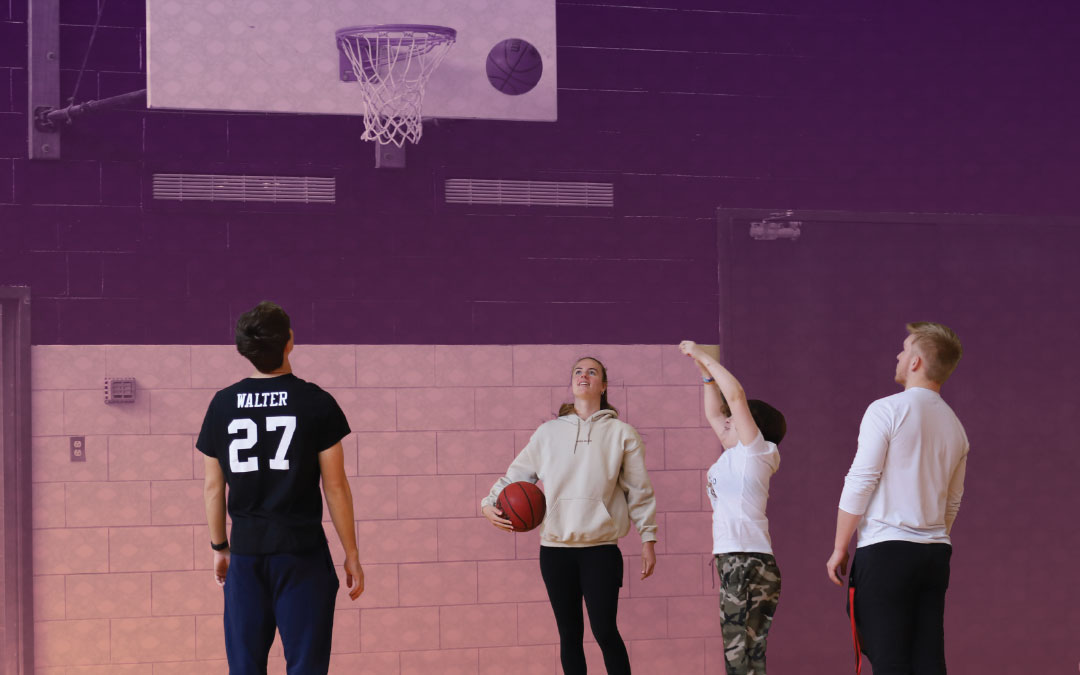“Keep going, keep going!” three Immaculata student trainers called, as a young woman, one of their GetFIT@IU clients, lifted a set of barbells.
As she moved on to a set of squats, the students cheered her on: “Come on, I think you can get one more!”
Later, during stretching, she reached to touch her toes, and the students rooted for her. “You got it! You’re killing it!” She beamed at their chorus of encouragement, breathing hard, pushing herself a little further each time.
“This is one of my favorite days of the week!” she said, after greeting each trainer with a hug.
You’d be hard-pressed to find anyone more excited to work out than Immaculata’s GetFIT clients. These adults with intellectual and developmental disabilities love working on their balance, strength and flexibility with IU’s student trainers and exercise science faculty.
“You’re supposed to enjoy movement,” said Laurie DiRosa, Ed.D., associate professor of exercise science, who brought GetFIT to IU in 2017. “So her enjoying that is spot-on with what we want.” DiRosa then joked that the clients love exercising more than she does. “And that’s what I do for a living!”
But DiRosa understands the magic that motivates the clients. “Those trainers make that special for her. It’s not just coming here and exercising. It’s the people.”
AN INGENIOUS PROGRAM WITH BENEFITS FOR ALL
DiRosa got involved with a GetFIT service-learning program at Rowan University, where it was established by the Family Resource Network of New Jersey. She started a version of GetFIT when she came to IU, which she believes is the only institution in the region to offer a program of this kind. DiRosa recruits her exercise science students as well as students of other majors to lead clients in fitness training once or twice a week. Students gain professional experience while clients improve their health—a win-win.

Master of Athletic Training student Randie Kuhar, left, assesses a client’s progress. Kuhar and the other GetFIT@IU trainers have seen every single client improve his or her balance, strength or flexibility by participating in the program.
GetFIT shifted to Zoom during the worst of the pandemic, but last fall, a smaller group returned to IU’s fitness center. DiRosa worked with Cole Racich, DPT, assistant professor of exercise science, and Randie Kuhar ’21, a graduate assistant in IU’s new Master of Athletic Training program, to create customized exercise plans for six clients.
After a few weeks, DiRosa, Racich and Kuhar assessed the clients, noticing both small gains and giant leaps. DiRosa said every client—about 30 since the program’s inception—has made some progress.
And the roughly 100 student trainers who have participated over the years have all made progress, too. Some have conducted research projects related to GetFIT. A few have decided to work full- time with people with disabilities. All of them have built their resumes and learned to interact with different kinds of people.
RESEARCH SHOWS RESULTS
Kuhar conducted a research project on balance, leading five GetFIT clients in a four-week intervention and concluding that it reduced their fall risk. “You really need balance to do just about everything in your daily life,” Kuhar said.
Alyssa Malitsky ’17 agrees. She was one of the first student trainers to participate in GetFIT and conducted similar research, confirming her hypothesis that improving core strength also improved balance. Now, as an occupational therapist at a rehabilitation hospital, Malitsky works on balance every day, helping patients sit or stand in stable positions for bathing, dressing and reaching.
“HE KEPT BLOOMING”
GetFIT typically works only with clients who are fully mobile, but DiRosa was determined to find a way to work with a male client who uses an assistive device to walk. Racich designed safe exercises to build the client’s balance and leg strength and help him achieve his goal of walking around Disney World.
To help this client perform a marching exercise, student trainer Dylan Walter ’25 suggested that he pretend he was walking around Disney. “That is not only a great motivator; it allows us to have a better relationship with him,” Walter reflected.
Kuhar agreed, observing that the client “just kept blooming more and more.” Though at first he could only sit and stand a few times, he can now do up to four sets of 10.
When trainer Christiana Lyras ’25 pointed out to a female client that she was ready for more difficult exercises, she replied, “Yay, I like being challenged!”
“They seem proud of themselves and how far they have come,” Lyras said. “They seem to all be motivating each other more and more,” trainer Cassandra DeFeo ’24 noted.
MOMENTS OF CONNECTION
Trainer Reese Mullins ’25 commented, “Through training the same clients weekly for months, you begin to form a connection with them, which goes beyond just completing their workout.” Some student trainers create personalized playlists for their clients to listen to during sessions. Students and clients chat about their families and compliment each other on their shoes and outfits.
“Each week they seem more comfortable with me, and I also feel more comfortable with them,” said trainer Kelly O’Brien ’22.
Trainer John Wilhelm ’25 observed that although his client was quiet at first, “recently he has really come out of his shell,” joking that he wanted to hit people with a rubber ball, even if they were out of his range.
“He found it hilarious,” Wilhelm said. The client teased Racich as his target, and Racich played along and took cover behind a box. “You can tell he pushes through and works harder in order to ‘throw the ball at someone,’” Wilhelm said.
INSPIRING GROWTH
At the beginning of the school year, DiRosa and Racich provided ample supervision, but the students soon learned to run sessions independently. “All of a sudden, they’re like, ‘See ya! I don’t need you, Mom!’” DiRosa joked.
Racich, who was previously a physical therapy clinical instructor, noted, “The skills our student trainers have developed while working with their GetFIT clients rival most doctoral PT students.”
“I am always so impressed by both the growth of our students professionally and the growth of our clients physically and socially,” DiRosa reflected. “Our joyful movement sessions never disappoint.”






